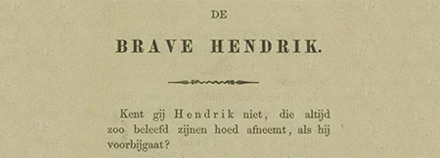Nineteenth century school books
De brave Hendrik (The well-behaved Henry) (1810) was a real educational bestseller in the first half of the 19th century. The book that Nicolaas Anslijn wrote about the good little boy Hendrik was widely used in schools and it remained a popular title for a long time.

Nowadays we regard the book as revoltingly virtuous. The minister and author Nicolaas Beets remarked as early as 1839 that the principal character, Hendrik, ’… een jongen [was], zo braaf, zo zoet, zo gehoorzaam, zo knap en zo goedleers, dat gij hem met plezier een paar blauwe ogen zoudt slaan, als gij hem op straat ontmoette’ (‘… was a boy so well-behaved, so good, so obedient, so clever and so eager to learn that you would enjoy slapping him silly if you met him in the street’). When De brave Hendrik was first published, it was – oddly enough – a genuinely innovative book. It expressed the Enlightenment belief that good behaviour was something children could be taught, which was a completely new idea at the time. The criticism of the book as time went by was the result of changing beliefs about the upbringing and education of children.

This collections consists of 200 old school books used for lessons in geography, history, reading, singing, physics, algebra, drawing and multi-sensory education. Between them, they give a good idea of what teaching materials looked like in the second half of the 19th century and of the social and political climate surrounding the Education Acts of 1806, 1857, 1878 and 1901. The collection varies from publications by the Maatschappij tot Nut van ’t Algemeen (Society for the Common Good) such as Trap der Jeugd (Stairs of Youth), to moralistic booklets like De Brave Hendrik and the reactions to it, such as De geschiedenis van Jozef (The story of Joseph) to works written in the time of Jan Ligthart, such as the Handleiding bij het leesplankje (Instructionds for the use of the primer]) by M.B. Hoogeveen.
